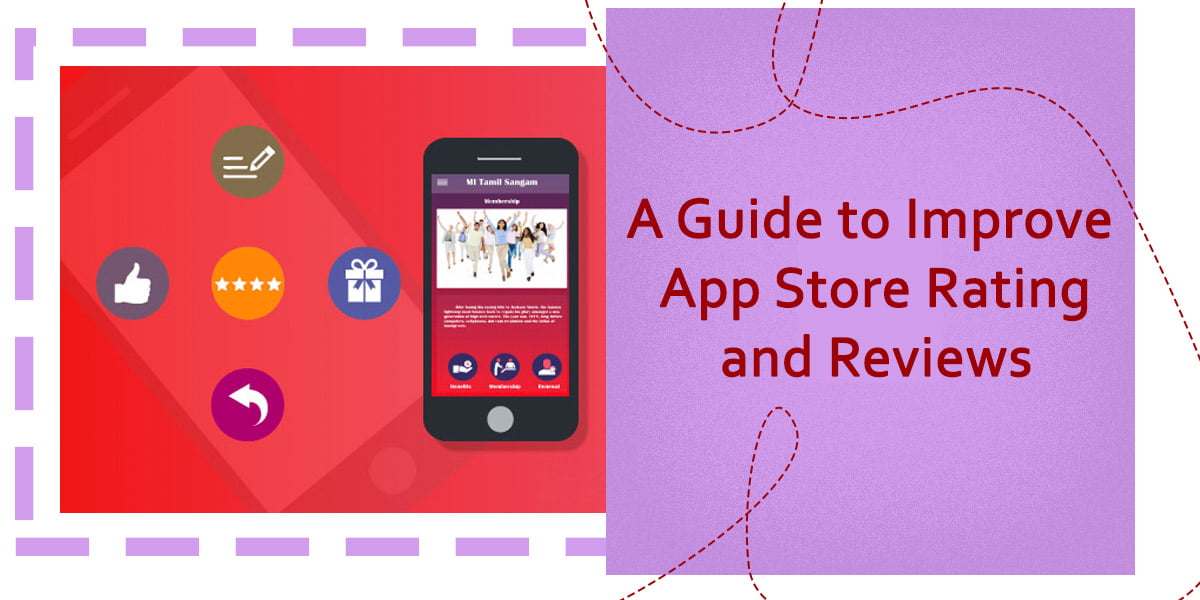A Guide to Improve App Store Rating and Reviews
In today’s digital age, mobile applications have become integral to our lives. There is an app for everything, whether for entertainment, productivity, or socializing. With millions of apps available in various app stores, it is becoming increasingly challenging for developers to stand out and attract users. One of the most critical factors in determining an app’s success is its rating and reviews on the app store. Positive ratings and reviews help boost an app’s visibility and increase user trust and credibility. In this guide, we will explore effective ways to improve your app’s rating and reviews, leading to better app performance and user engagement.
Understanding App Store Ratings and Reviews
App store ratings and reviews are essential elements for mobile app success. Stars typically represent ratings ranging from 1 to 5, which indicate the average user satisfaction with an app. Reviews are written comments that provide further insights into an app’s features, functionality, and performance. Higher ratings and positive reviews can influence an app’s visibility, credibility, and engagement, leading to increased downloads and revenue. Factors contributing to app store ratings and reviews include app functionality, usability, design, customer support, and frequency of updates. App developers must pay close attention to user feedback and continually improve their apps to maintain high ratings and positive reviews.
Tips for Improving App Store Ratings and Reviews
Encouraging Users to Leave Feedback
One of the most effective way to improve app store ratings and reviews is by encouraging users to leave feedback. This can be done by sending push notifications, in-app prompts, or emails asking for their thoughts on the app. It is essential to make the process as simple as possible for users by providing clear instructions and avoiding lengthy surveys. Developers can also incentivize users by offering rewards or exclusive features for leaving a review. Additionally, addressing user feedback promptly and implementing suggested improvements can encourage users to leave positive reviews and increase their satisfaction with the app. By actively seeking feedback and continuously improving the app, developers can improve their app store ratings and reviews and enhance user experience and retention.
Responding To User Feedback
Another way to improve app store ratings and reviews is by responding to user feedback. Users appreciate it when developers take the time to acknowledge and address their concerns or suggestions. Responding to user feedback can also help to build a positive relationship between the app and its users, which can result in improved app ratings and reviews. Developers should be prompt, courteous, and transparent when responding to user feedback. For example, if a user reports a bug, the developer should promptly investigate the issue and provide a solution or workaround. If a user suggests a new feature, the developer should acknowledge the suggestion and provide an update on whether it will be implemented. By responding to user feedback, developers can show users that they are listening and committed to improving the app, which can lead to improved ratings and reviews.
Improving App Functionality and Usability
Improving app functionality and usability can also improve app store ratings and reviews. Developers should ensure that their app is user-friendly and performs its intended functions without errors. This can be achieved by testing the app thoroughly before releasing it and regularly checking for bugs and glitches. Developers should also pay attention to user feedback and use it to improve the app’s features and functionality. Making the app intuitive and easy to use can enhance user experience and satisfaction, leading to positive ratings and reviews. Providing clear and concise instructions within the app can help users understand how to use it properly and minimize confusion or frustration. By continually improving app functionality and usability, developers can attract more users and maintain a high rating on the app store.
Updating The App Regularly
Regularly updating the app can also help improve app store ratings and reviews. Regular updates can address user feedback, fix bugs, and improve the app’s features and functionality. Updating the app also shows users that the developer is committed to improving the app and maintaining its performance. Users are more likely to leave positive reviews and ratings for an app that is regularly updated and improved. Developers should aim to release updates on a regular schedule and inform users of the changes or improvements made to the app. This can help to build trust and loyalty among users, which can lead to better app store ratings and reviews.
Incentives For Users to Leave Reviews
Offering incentives for users to leave reviews can effectively improve app store ratings and reviews. In exchange for leaving a review, developers can offer incentives such as in-app credits, exclusive content, or discounts on future purchases. These incentives can encourage users to leave a review and help to increase user engagement with the app. However, developers should ensure that the incentives offered are genuine and do not violate app store policies. It is also essential to avoid incentivizing users to leave positive reviews or mislead them. Creating honest feedback is crucial for improving the app and maintaining user trust. By offering appropriate incentives, developers can encourage users to leave reviews, increasing visibility and ratings on the app store.

Strategies for Dealing with Negative Reviews
Responding To Negative Reviews
Dealing with negative reviews can be challenging, but it is crucial for maintaining a positive app store reputation. One strategy for dealing with negative reviews is responding promptly and professionally. Developers should take the time to read and understand the user’s feedback and address their concerns or complaints. Responding to negative reviews shows users that the developer is attentive and committed to resolving issues and improving the app. Developers should be polite in their responses and avoid being defensive or aggressive. Acknowledging the user’s feedback and providing a solution or explanation for the issue is also essential. By responding to negative reviews, developers can show users that they value their feedback and are committed to improving the app, which can lead to improved app store ratings and reviews.
Addressing User Concerns and Resolving Issues
Another strategy for dealing with negative reviews is addressing user concerns and resolving issues. Developers should take the time to investigate the issue and provide a solution or workaround for the user’s problem. It is essential to be transparent and honest with users and provide regular updates on the issue’s status. Addressing user concerns and resolving issues can also help to prevent similar problems from occurring in the future. Developers should also consider offering a refund or compensation to the user, depending on the severity of the issue. By addressing user concerns and resolving issues, developers can turn a negative experience into a positive one and potentially change a negative review into a positive one. It is important to show users that their feedback is valued and that the developer is committed to improving the app and providing a positive user experience.
Improving The App Based on User Feedback
Improving the app based on user feedback is another effective strategy for dealing with negative reviews. Developers should pay close attention to user feedback, identify common issues or complaints, and work to address them in future updates. It’s essential to be responsive to user feedback and prioritize changes that will significantly impact on user experience. Developers should also communicate with users and inform them of the changes or improvements made based on their feedback. By improving the app based on user feedback, developers can show users that their opinions are valued and that the developer is committed to providing the best possible user experience. This can increase user satisfaction and positive app store ratings and reviews.
Maximizing Positive Reviews
Encouraging Satisfied Users to Leave Reviews
Maximizing positive reviews is essential for improving app store ratings and reviews. One strategy for achieving this is by encouraging satisfied users to leave reviews. Developers can prompt users to leave a review after completing a particular action within the app, such as making a purchase or achieving a milestone. It is important to make the review process as simple as possible and avoid overwhelming users with too many prompts or requests. Developers can also consider offering a small incentive for leaving a review, such as in-app credits or exclusive content. However, it’s crucial to avoid incentivizing users to leave a positive review or mislead them. By encouraging satisfied users to leave reviews, developers can increase the number of positive reviews and improve the app’s visibility and ratings on the app store.
Offering Incentives for Positive Reviews
Offering incentives for positive reviews is not recommended as it goes against the policies of most app stores. Incentivizing users to leave positive reviews can be considered dishonest and misleading, damaging the app’s reputation and credibility. Developers should prioritize genuine and honest feedback, as it helps identify improvement areas and maintain user trust. Instead of offering incentives for positive reviews, developers can focus on improving the app’s functionality, usability, and overall user experience. This can lead to increased user satisfaction and positive reviews naturally. By prioritizing user satisfaction and providing a high-quality app, developers can maximize positive reviews and improve the app’s ratings and visibility on the app store.
Highlighting Positive Reviews on The App Store Page
Highlighting positive reviews on the app store page can be an effective strategy for maximizing positive reviews. Developers can feature positive reviews prominently on the app store page, such as in the app’s description or a separate section dedicated to user reviews. This can help to catch the attention of potential users and increase the app’s visibility and credibility. However, it is essential to ensure that the reviews selected accurately represent the app’s user feedback, not just a select few. Developers can also respond to positive reviews, thanking users for feedback and acknowledging their support. By highlighting positive reviews on the app store page, developers can increase the app’s appeal and encourage more users to download and use the app.
Bottom Line
App store ratings and reviews play a critical role in the success of any mobile application. They can significantly impact the app’s visibility, credibility, and user perception. Therefore, it is crucial for developers to prioritize user feedback and implement strategies for improving app store ratings and reviews. This guide covered various tips and strategies for improving app store ratings and reviews, such as encouraging user feedback, responding to negative reviews, improving app functionality, updating the app regularly, and more. By implementing these strategies, developers can maximize positive reviews and address negative reviews, leading to increased user satisfaction and improved app store ratings. In summary, developers should prioritize user feedback and proactively address user concerns and improve the app’s user experience.
Finally, we recommend that developers continue to monitor user feedback regularly and make necessary changes or updates to the app based on user feedback to maintain user satisfaction and improve the app’s ratings and success in the app store.





